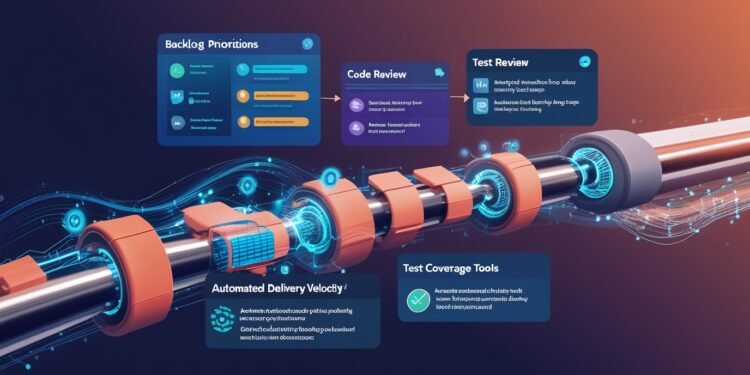Solution delivery teams are under immense pressure to ship faster, reduce costs, and maintain quality. But disruptions—like shifting requirements, fragmented workflows, and endless context switching—are sabotaging throughput. In a world that demands agility at scale, it’s time for teams to embrace AI not just as a tool, but as a powerful partner in accelerating value delivery.
This isn’t about hype—it’s about necessity. Traditional approaches to improving throughput simply can’t keep pace with the demands of today’s complex, interconnected digital ecosystems. AI is not a silver bullet, but when applied with intention, it can be a game-changer across the entire solution delivery pipeline.
The Throughput Crisis
Modern solution delivery faces a paradox: velocity is expected, yet distractions are increasing. Teams spend more time firefighting than innovating. Common friction points include:
- Manual reporting and status updates that steal hours from sprints
- Unclear requirements leading to costly rework and frustration
- Slow feedback loops between code commits and business validation
- Inefficient context switching between tasks, tools, and stakeholders
Layer on hybrid work models, distributed teams, and ever-expanding tech stacks, and it becomes clear: throughput is getting crushed under the weight of noise.
This is where AI comes in. Applied correctly, AI doesn’t replace the human developer—it frees them. It clears blockers, removes repetition, and boosts clarity across complex systems. It creates the conditions for deep work, faster iteration, and smarter delivery.
Why Solution Delivery Teams Should Embrace AI
AI augments—not replaces—human expertise. Forward-thinking delivery teams aren’t using AI to automate their way out of complexity. They’re using it to amplify their strengths, reduce cognitive load, and unlock higher-value output.
- Enhanced Decision-Making: AI can surface risk-prone areas in codebases, predict delays in delivery pipelines, and recommend priority shifts based on real-time data from tools like Jira, GitHub, and Datadog.
- Reduced Manual Load: From auto-generating documentation to AI-powered test coverage reports, these tools eliminate tedious tasks that drain developer focus and introduce inconsistency.
- Smarter Planning: AI-driven sprint analytics help teams forecast with more accuracy and adapt mid-sprint without chaos. This kind of dynamic capacity management is no longer a luxury—it’s a requirement.
- Stronger Feedback Loops: AI can instantly analyze pull requests, summarize comments, and even recommend fixes—closing feedback loops that traditionally take days, in seconds.
Key AI Use Cases Across the Delivery Pipeline
AI is not a monolithic tool. It offers tactical support at every stage of the delivery lifecycle:
1. Backlog Intelligence
AI can analyze historical sprint data, story points, customer support tickets, and usage analytics to suggest backlog priorities that align with both business goals and technical feasibility.
2. Automated Testing & QA
Generative AI can produce test cases directly from acceptance criteria or code changes, reducing the gap between code and quality. Some teams are deploying LLMs to build test suites, identify edge cases, and simulate user journeys at scale.
3. Knowledge Retrieval & Internal Search
AI models can be fine-tuned on internal documentation, codebases, Confluence pages, and Slack history to provide instant, context-aware answers to developer questions—reducing time wasted hunting for information.
4. Code Review Automation
AI-powered tools like GitHub Copilot, CodeWhisperer, and CodeGuru assist in detecting bugs, optimizing logic, and enforcing secure coding practices during reviews—making code review faster, more consistent, and less prone to human fatigue.
5. Change Impact Analysis
AI can trace the impact of a single line of code across services, APIs, and data pipelines, offering predictive insight into what might break—and where to test before deployment.
6. Release Risk Scoring
Based on commit volume, test coverage, and change history, AI can score the risk of a release, giving teams an early warning system before problems hit production.
Best Practices for AI Adoption in Solution Delivery
- Start with the bottlenecks: Use AI where delays or rework are hurting your throughput the most—like QA, handoffs, or sprint planning.
- Design feedback loops: Train your AI models with labeled examples of good vs. bad outputs to improve their relevance.
- Involve developers early: AI tools must be embraced—not enforced. Involve engineers in selection, integration, and feedback.
- Prioritize explainability: Ensure your AI provides insights in ways that are transparent and actionable, not black-box suggestions.
- Don’t over-automate: The goal is augmentation, not replacement. Preserve human creativity and autonomy.
Conclusion: Let AI Unblock Your Flow
The future of solution delivery isn’t about working longer—it’s about working smarter. High-performing teams don’t just rely on velocity—they engineer their environments to support velocity. AI is the enabler of that support: lifting the noise, removing the drag, and unlocking the full creative potential of every team member.
If your team is still approaching solution delivery with legacy methods, it’s time to step forward. AI can help you scale not just throughput—but innovation itself.
Throughput is no longer limited by headcount—it’s powered by intelligence.


















